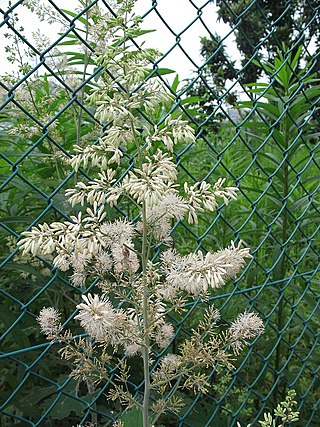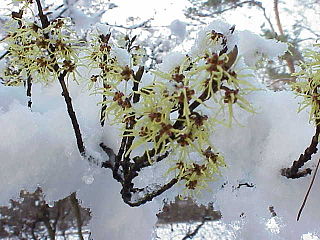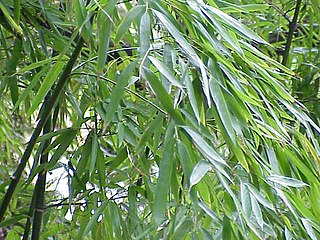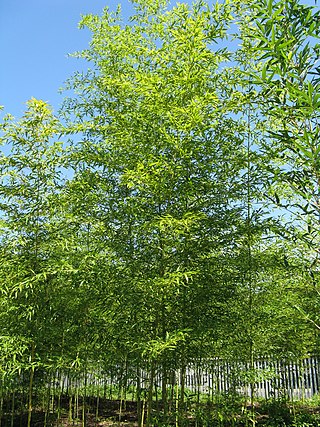
Phyllostachys is a genus of Asian bamboo in the grass family. Many of the species are found in central and southern China, with a few species in northern Indochina and in the Himalayas. Some of the species have become naturalized in parts of Asia, Australia, the Americas, and southern Europe.

Chamaecyparis pisifera is a species of false cypress, native to central and southern Japan, on the islands of Honshū and Kyūshū.

Abutilon pictum, syn. Abutilon striatum (disputed), is a species of flowering plant in the family Malvaceae. It is native to southern Brazil, Argentina, Paraguay and Uruguay. The plant has become naturalised in Central America, and is used in horticulture. Common names include redvein abutilon, red vein Indian mallow, redvein flowering maple, Chinese-lantern and red vein Chinese lanterns.

Phyllostachys nigra, commonly known as black bamboo or purple bamboo, is a species of bamboo, native to Hunan Province of China, and is widely cultivated elsewhere.

Phyllostachys aureosulcata, the yellow groove bamboo, is a species of bamboo native to the Zhejiang Province of China. It is a running bamboo with a distinctive yellow stripe in the culm groove that is often grown as an ornamental.

Cornus alba, the red-barked, white or Siberian dogwood, is a species of flowering plant in the family Cornaceae, native to Siberia, northern China and Korea. It is a large deciduous surculose (suckering) shrub that can be grown as a small tree. As a popular ornamental used in landscaping its notable features include the red stems in fall (autumn) through late winter, bright winter bark; and the variegated foliage in some cultivars, such as C. alba 'Elegantissima'. C. alba can grow to 3 m (10 ft) high, but variegated forms are less vigorous. For the brightest winter bark, young shoots are encouraged by cutting to the ground some older stems at the end of the winter, before leaves are open. The oval fruits are white, sometimes tinted blue.

Macleaya cordata, the five-seeded plume-poppy, is a species of flowering plant in the poppy family Papaveraceae, which is used ornamentally. It is native to China and Japan. It is a large herbaceous perennial growing to 2.5 m (8 ft) tall by 1 m (3 ft) or more wide, with olive green leaves and airy panicles of buff-white flowers in summer.

Chusquea culeou, the Chilean bamboo, is a species of flowering plant in the grass family Poaceae. An evergreen bamboo native to South America, unlike most species within the genus Chusquea, it is frost-tolerant and thus widely cultivated in temperate regions.

Hamamelis mollis, also known as Chinese witch hazel, is a species of flowering plant in the witch hazel family Hamamelidaceae, native to central and eastern China, in Anhui, Guangxi, Hubei, Hunan, Jiangxi, Sichuan, and Zhejiang.

The Bambouseraie de Prafrance is a private botanical garden specializing in bamboos, located in Générargues, near Anduze, Gard, Languedoc-Roussillon, France. It is open daily in the warmer months; an admission fee is charged.

Acacia pravissima, commonly known as Ovens wattle, Oven wattle, wedge-leaved wattle and Tumut wattle, is a species of flowering plant in the legume family Fabaceae. It is an evergreen shrub native to Victoria, the South West Slopes and Southern Tablelands of New South Wales, Australia.

Phyllostachys aurea is a species of bamboo, and is of the 'running bamboo' type, belonging to the diverse Bambuseae tribe. It is native to Fujian and Zhejiang in China. It is commonly known by the names fishpole bamboo, golden bamboo, monk's belly bamboo, and fairyland bamboo (Australia).

Acer palmatum, commonly known as Japanese maple, palmate maple, or smooth Japanese maple (Korean: danpungnamu, 단풍나무, Japanese: irohamomiji, イロハモミジ, or momiji,, is a species of woody plant native to Korea, Japan, China, eastern Mongolia, and southeast Russia. Many different cultivars of this maple have been selected and they are grown worldwide for their large variety of attractive forms, leaf shapes, and spectacular colors.

Semiarundinaria fastuosa, the Narihira bamboo, Narihira cane or Narihiradake, is a species of flowering plant in the grass family Poaceae, native to Japan. Growing to 7 m (23 ft) tall by 2 m (7 ft) broad, it is a vigorous, evergreen bamboo with dark green cylindrical canes and dense tufts of lanceolate, glossy green leaves, up to 20 cm (8 in) long.

Pseudosasa japonica, the arrow bamboo or metake, is a species of flowering plant in the grass family Poaceae, native to Japan and Korea. This vigorous bamboo forms thickets up to 6 m (20 ft) tall with shiny leaves up to 25 cm (9.8 in) long. The culms are typically yellow-brown and it has palm-like leaves. The common name "arrow bamboo" results from the Japanese Samurai using its hard and stiff canes for their arrows. It grows up to 4 cm (1.6 in) a day.

Fargesia murielae, the umbrella bamboo, is a species of flowering plant in the family Poaceae. It is a large, clump-forming evergreen bamboo, closely resembling Fargesia nitida in the same genus, but with yellow canes.

Phyllostachys bambusoides, commonly called madake, giant timber bamboo, or Japanese timber bamboo, is a species of flowering plant in the bamboo subfamily of the grass family Poaceae, native to China, and possibly also to Japan.

Hypericum kouytchense, the large-flowered St John's wort, is a species of flowering plant in the family Hypericaceae, native to Western China. Growing up to 3 ft (0.91 m) tall and 5 ft (1.5 m) wide, it is a semi-evergreen rounded shrub with blue-green leaves and large yellow flowers with prominent stamens, appearing in midsummer. Flowers are followed by red seed capsules in autumn. Where conditions are favourable it can retain its leaves all year.

Indocalamus tessellatus, the large-leaved bamboo, is a species of flowering plant in the grass family Poaceae, native to China. A medium-sized, hardy evergreen bamboo growing to 2 m (6.6 ft), it forms a clump of broad leaves 60 cm (24 in) long and up to 10 cm (3.9 in) wide – the broadest of any bamboo – which cause the slender cane to bend under their weight. Though hardy down to −15 °C (5 °F) and able to survive conditions in most of the UK, it prefers a sheltered site in semi-shade with moist, rich soil. Given the best conditions possible, it will eventually form large thickets or groves, but can be kept in a large container. In cultivation in the UK it has gained the Royal Horticultural Society's Award of Garden Merit.

Lonicera similis is a species of flowering plant in the family Caprifoliaceae, native to Western China. This honeysuckle is known in cultivation by the variety delavayi which is reported by some authorities to be synonymous with L. similis itself. It is a large, twining, semi-evergreen shrub growing to 8 m (26 ft) tall by 1.5 m (4.9 ft) broad, with a profusion of fragrant tubular flowers opening white and ageing to yellow, in late summer and autumn. The flowers are followed by black berries. The Latin specific epithet similis means "similar to". It is similar in appearance to L. japonica, but larger and more robust. The name delavayi honours the French missionary and botanist Père Jean Marie Delavay (1834-1895).





















